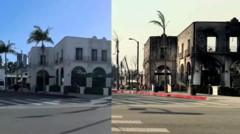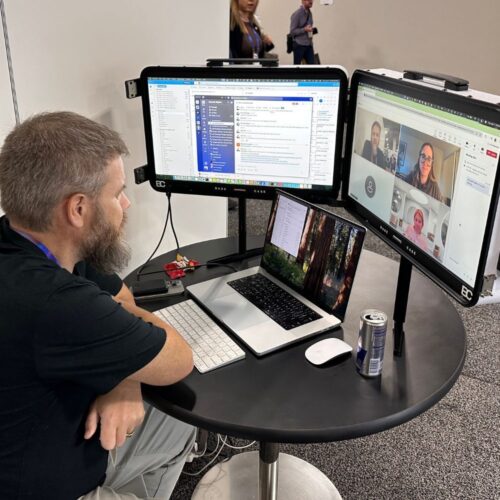Normal view
-
Latest Tech News from CNBC
- Ahead of looming ban, TikTok creators ask fans to find them on Instagram or YouTube
-
Latest News
- Not everyone in the Palisades is wealthy. I'm a 22-year-old renter with multiple jobs who evacuated.
Not everyone in the Palisades is wealthy. I'm a 22-year-old renter with multiple jobs who evacuated.

Tabitha Snavely
- 22-year-old Tabitha Snavely evacuated her apartment ahead of the Palisades wildfire.
- Snavely, who works multiple jobs, said many in her building were blue-collar workers or older people.
- She evacuated to her parents' house and told BI she needs to find a new place to live that is closer to work.
This as-told-to essay is based on interviews with Tabitha Snavely, a 22-year-old living in the Palisades. Her identity and employment has been verified by Business Insider. This story has been edited for length and clarity.
I'm 22 years old, and I live alone in a rented medium-sized apartment building in the Palisades. I've lived in California my whole life so this isn't my first time dealing with a fire.
On Tuesday night, I woke up to the alert of an evacuation. I had about 45 minutes to pack and feed my dog really quickly because I didn't know when we'd be in a safe area. As I was packing up, I started smelling smoke in my unit. As soon as I started smelling the smoke, I was like, "OK, I need to leave now."
I threw some clothes in a suitcase, grabbed my dog, loaded up my car, and started driving. I grabbed everything that I had the instinct to get out in an emergency, like my phone, laptop, some clothes.
When I pulled out of the parking garage, I could see so much smoke and then hundreds of cars trying to get out. Luckily, I am closer to the Pacific Coast Highway, so I was able to get out pretty quick.
I evacuated to San Diego. My family thought it was a better idea for me to evacuate here with them than to go to a friend's in Santa Monica or Hollywood because as the fire keeps growing, more people seem to keep getting evacuated.
The aftermath
I saw on the Watch Duty app on Wednesday that my apartment building was in a bright red zone — indicating it was in the path of the fire. My unit specifically is tucked away on the inside of the building, so I was hoping that not everything in my unit was demolished.
I planned to check on it over the weekend. Now, I've seen news footage showing my street and buildings that burned, including my apartment building.
@tabithasnavely i miss my apartment. i wanna go home. #palisadesfire #pacificpalisades #pacificpalisadesfire #evacuationzone #evacuationroute #emergencyevacuation #losangeles #losangelesfires #socal #socalfires #socalfire #californiafire #californian #californiafires #california #pacificpalisadescalifornia #pacificpalisadesvillage #palisadesvillage #thepalisades #losangelesfire #palisadescharterhighschool #malibu #malibufire #brentwood #santamonica #westla #westsidelosangeles #westsidela #downtown #downtownlosangeles #dtla #palisadeshome #downtownla #palisadesbluffs ♬ The End of the World - Skeeter Davis
Everything I left behind may now be gone: photos, books, my college diploma. I had my great-grandmother's quilt that she made for me before she passed away. I also had a set of plates and mugs that my grandma gave to me when she died. A lot of my things are thrifted or are hand-me-downs so they're not easily replaceable.
At the same time, my parents are selling their house, so the place I could stay for evacuation, although it isn't close to my job, is very temporary. I feel like a floater with nowhere to go because I don't want to impose on my friends too long without a secure plan for where to go.
A lot of my friends live in Santa Monica, Brentwood, or Malibu, and they have been starting to get evacuated now, but some of them have been able to return to their homes.
I'm close with a lot of the older people who have lived in the Palisades for decades. I would hang out with them at the coffee shops for hours. I don't know how any of them are doing because many of them only have home phones and not cellphones.
I have a hard time feeling at home, but this apartment finally felt like home. I loved everything about it.
It's not only wealthy people living in the Palisades
I know also that a lot of people think that the Palisades is very wealthy, but I don't feel rich. I have multiple jobs. A lot of the people in my building are blue-collar workers, and there are a lot of older people in the Palisades.
I work at a coconut water company, which allowed me to work remotely for the next week before returning in person. I also am a personal assistant for someone who owns a film production company, which also gave me the week off.
Luckily, I have renter's insurance, but I don't know where I will be living. Airbnb has offered a free week to people who have lost their homes, but I filled out the form and haven't heard anything back yet.
I have friends who have offered their couches for me to sleep on while I figure out what to do next, but I still do not have a definitive plan because I've been so scatterbrained since the fire evacuation alert woke me up.
I think we need to keep more compassion alive at this time because online, I've been seeing a lot of people say that the Palisades is very rich and they can all just afford to rebuild.
No one deserves to lose their home.

Palisades Fire Latest: Celebrity Homes Under Threat As Blaze Spreads
American Red Cross Gets a Flood of Support Following California Wildfires
-
Celebrity News, Exclusives, Photos and Videos
:max_bytes(150000):strip_icc():format(jpeg)/Three-Family-Members-Each-Lose-a-Home-in-LA-Fires-011224-01-c9c2f8a4194a4073a5eb1889dcc935cf.jpg)
- 3 Family Members Feeling ‘Helpless’ After Each of Their Homes Is Destroyed in L.A. Fires: ‘We Still Have to Cover Our Mortgage'
3 Family Members Feeling ‘Helpless’ After Each of Their Homes Is Destroyed in L.A. Fires: ‘We Still Have to Cover Our Mortgage'

-
Celebrity News, Exclusives, Photos and Videos
:max_bytes(150000):strip_icc():format(jpeg)/Ill-Come-to-You-by-Rebecca-Kauffman-Playworld-by-Adam-Ross-and-Leave-No-Trace-by-Jo-Callaghan-010725-115f5ee6c84c482dad8ac146d53ed470.jpg)
- PEOPLE’s Best Books of January 2025: New Fiction from Rebecca Kauffman, Adam Ross and More
PEOPLE’s Best Books of January 2025: New Fiction from Rebecca Kauffman, Adam Ross and More

The Best Obesity Drugs Aren’t Even Here Yet
A new review highlights the future of anti-obesity medications that could outperform today's already blockbuster drugs like Ozempic.
Germany says Russian 'shadow' ship stuck in Baltic Sea

Before and after footage reveals scale of damage after LA wildfires

CFP 12-team playoff a success despite a few wrinkles




Panasonic Z95A OLED TV Review: Searing Brightness and Colors

The 8 most interesting PC monitors from CES 2025
Plenty of computer monitors made debuts at the Consumer Electronics Show (CES) in Las Vegas this year, but many of the updates at this year's event were pretty minor. Many could have easily been a part of 2024's show.
But some brought new and interesting features to the table for 2025—in this article, we'll tell you all about them.
LG’s 6K monitor
Pixel addicts are always right at home at CES, and the most interesting high-resolution computer monitor to come out of this year's show is the LG UltraFine 6K Monitor (model 32U990A).


-
World News - Breaking international news and headlines | Sky News

- Explosion at fuel station in Yemen kills 15
Explosion at fuel station in Yemen kills 15

Suspected Shoplifter Poops in Florida Store, Robs It With Accomplice, Video
A Guide to Demi Moore and Bruce Willis' Blended Family
LA area fires: Climate change playing key contributing, but not sole, role
Climate change — particularly whiplash between two wet winters followed by a bone-dry, unusually hot spring, summer and fall — set the stage for Los Angeles' deadly and devastating fires, scientists say.
- The firestorm was the product of what climate researchers refer to as "hydroclimate whiplash."
- Other factors include one of the worst Santa Ana wind events of the past two decades; land use patterns; and sparks set off by power lines, car engines, arsonists and other potential ignition sources.
Why it matters: Whatever the source, it's clear a changing climate made the fires more ferocious, long-lasting and destructive, as has been the trend across the West in recent decades.
Threat level: Though winds are no longer as strong, the overall conditions that led to the extraordinary rates of fire spread haven't abated.
- That may only come with significant rainfall, which currently isn't in sight.
Zoom in: Hydroclimate whiplash occurs when one extreme precipitation regime is replaced by another.
- In this case, extremely wet conditions are followed almost immediately by parched weather patterns, typically accompanied by above average temperatures.
- This leads to a green up of vegetation that then dries out through evaporation, leading to ample "fuels" for a blaze to burn.
- The strong winds — which reached 99 mph in some locations — acted as an "atmospheric blow dryer" on trees and other vegetation, further drying out the landscape and ensuring any fire wouldn't stay small for long, UCLA climate scientist Daniel Swain said in an online video briefing.
Stunning stat: In downtown Los Angeles, just 0.16 inches of rain has fallen since May 6, compared to the average of greater than 4 inches, per the National Weather Service.
- This is the city's second-driest May 6 to Dec 31 period on record, according to the National Weather Service's Los Angeles forecast office.
- No rain is in the forecast through early next week, with one Santa Ana event diminishing this morning, and another potentially strong one forecast for early in the coming week.
Zoom out: The see-saw pattern between wet and dry periods isn't new for Californians. But these swings are becoming acute — and not just in the Golden State.
- A new study published last week shows these swings are becoming more of a trigger for wildfires, floods and drought globally.
- In the study, scientists refer to an increasingly "expanding atmospheric sponge," since the atmosphere is able to evaporate, absorb and release 7% more water vapor for every 1°C (1.8°F) that the temperature increases.
In other words, the atmosphere gets more thirsty as the climate warms, drawing more moisture from plants, and leading to more days with extreme fire weather conditions.
- This analogy captures the atmosphere's ability to absorb a larger and larger amount of water vapor as temperatures increase, and wring out more and more water due to such temperature changes.
- Data shows this whiplash effect has increased by between 31% to 66% globally since the mid-20th century, and that the rate of increase is speeding up.
Between the lines: If global average temperatures increase by about 3°C (5.4°F) — which is currently likely — then the whiplash effect will more than double in its intensity.
- "Increasing hydroclimate whiplash may turn out to be one of the more universal global changes on a warming Earth," Swain said in a statement.
- Though the rare, powerful winds are fanning the blazes, it's the whiplash-driven lack of rain that has trapped Southern California in a seemingly never-ending fire season.
- In addition to the increased thirstiness of the atmosphere and see-sawing from floods to droughts and back again, studies show that climate change is increasing the odds that windy periods occurring deeper into the traditional "rainy season" will overlap with extreme dryness.
- This overlap is another crucial tie between the ongoing California fires and long-term, human-caused climate change.
The intrigue: Land management, the use of prescribed burns and expanding building in fire-prone areas have also contributed to this wildfire nightmare. But climate change is a large, and growing factor.
- "Whether we like it or not, the nature of wildfire in Southern California is changing and we must adapt accordingly," said UCLA climate scientist Alex Hall in a statement.
- "That will involve some frank conversations about the tradeoffs involved in improving our strategies to reduce ignitions, improve stewardship of our unique chaparral landscapes to reduce impacts, and protect human life and property."
The bottom line: Climate change didn't provide the spark that caused each of these catastrophic fires in LA County. But it's making such fires worse.


Injured animals take cover at LA animal rescue in heartbreaking video
More than 400 animals have taken cover at an animal welfare charity as they fled the devastating California wildfires.

© Pasadena Humane
China is winning the race for green supremacy
The best actually real stuff at CES 2025

Hi, friends! Welcome to Installer No. 66, your guide to the best and Verge-iest stuff in the world. (If you’re new here, welcome, happy 2025, and also you can read all the old editions at the Installer homepage.)
This week, I’ve been reading about loneliness and Web3 scams and the future of procedural TV, watching Deadpool & Wolverine on an airplane like the director intended, rewatching Severance and Squid Game to get ready for the second seasons, eagerly awaiting the return of Kids Baking Championship, wondering if that’s real Sara Dietschy or AI Sara Dietschy, and giving an Apple News Plus subscription a whirl as my go-to news source.
I also have for you a big report from CES in Las Vegas. This edition of Installer is a little different than most, just because we saw so many new things, and so many new things launched, and in many cases, it’s hard to know whether any of it will ever hit shelves. So think of this as part Installer, part CES recap, part “David hopes desperately these things actually ship” list. But I tried hard to pick out the stuff I’m confident will actually end up on sale at some point soon and might be worth your money. I’m sure I’ll be wrong about a few...
-
Latest News
- China and its military have been making some big moves ahead of Trump's return to the White House
China and its military have been making some big moves ahead of Trump's return to the White House

Pu Haiyang/VCG via Getty Images
- China has been busy lately showcasing its military might and hybrid warfare tactics.
- The moves come ahead of Trump's return to the White House this month.
- Its activities highlight China's ambitions and intentions and the challenge it poses.
Since the 2024 US presidential election, China has been surprisingly busy with overt and covert displays of might that represent a challenge for the US, both the current and incoming administrations.
China, long identified as the Pentagon's "pacing challenge," has flexed new military capabilities, increased pressure on US allies and partners, and engaged in hybrid warfare in cyberspace.
Over the past couple of months, suspected next-generation Chinese combat aircraft have appeared, China's navy has launched new warships, the Chinese military simulated a naval blockade of Japan for the first time and carried out massive drills near Taiwan, the US has blamed Chinese hackers for major hacks of the Treasury Department and telecommunications firms, and concerns have been raised about China's involvement in damage to critical undersea infrastructure.
Some of Beijing's recent actions might be "part of a long-term strategy to shape a new (or returning) administration's approach to China and deter external support for Taiwan," Matthew Funaiole, a senior fellow with the China Power Project at the Center for Strategic and International Studies, told Business Insider.
China has been flexing its military muscles in a big way

GREG BAKER/AFP via Getty Images
China deployed around 90 of its navy and coast guard vessels around Taiwan, as well as southern Japanese islands, for a large-scale exercise, Taiwan said in December. Beijing didn't announce anything ahead of time and hasn't acknowledged it as a military drill.
Taiwan recorded over 60 incursions into its air defense identification zone and said Chinese forces were simulating attacks on foreign ships and disrupting the navigation of others.
The exercise was China's largest since the 1996 Taiwan Strait Crisis. It followed Taiwanese President Lai Ching-te's visit to several Pacific partners, which Beijing condemned, and came ahead of Trump's return to the White House. China routinely ramps up demonstrations of military power at symbolically important times for both international and domestic audiences.
Giselle Donnelly, a senior fellow in defense and national security policy at the American Enterprise Institute, said that the timing of these exercises "is more than coincidence," not unlike Russian President Vladimir Putin's efforts over the last few months to put pressure on Ukraine before Trump takes office and US aid to Kyiv faces an uncertain future.

SAM YEH/AFP via Getty Images
Chinese leadership may see exercises like this as a way to "get an early read" on the incoming Trump administration's approach to US-Chinese politics, she added.
In December, China also held military exercises resembling a naval blockade in the Miyako Strait between Japan's main island and Miyako Island, Japanese officials told The Yomiuri Shimbun, which reported the news earlier this month.
And just before ringing in 2025, China announced its air and naval forces were conducting combat readiness patrols around the Scarborough Shoal, a disputed area in the South China Sea near the Philippines that was the site of heightened and repeated confrontations between Beijing and Manila last year. Chinese vessels were accused of harassing Philippine ships, in some cases ramming them and blasting crews with water.
China has unveiled new capabilities

People's Liberation Army News Communication Center
In November, China unveiled advanced aircraft at its Zhuhai Airshow, including the J-35A land-based stealth fighter. The Chinese developer hailed the fifth-gen jet's stealth, informationization, and networking capabilities, calling it a "point guard" for Chinese airpower — similar to how the F-35 stealth fighter has been referred to as a "quarterback" by Lockheed Martin and the US military.
The next month, however, China surprised Chinese aviation watchers with what observers suspect are prototypes of next-generation aircraft. The Pentagon said in its latest Chinese military power report that Beijing is developing new medium- and long-range stealth bombers to strike regional and global targets." It's unclear if the aircraft, which were flown in broad daylight, are part of those efforts.

VCG/VCG via Getty Images
China also launched the warship CNS Sichuan, China's first Type 076, and the world's largest amphibious assault vessel — an upgrade from China's Type 075 warship. The large ship features an electromagnetic catapult system for launching and retrieving fixed-wing and unmanned aircraft.
For several years now, the US Department of Defense has noted China's growing navy, already the world's largest, and shipbuilding prowess, as the industrial juggernaut churns out new vessels.
China has been called out for dangerous cyber activity

Allison Robbert/Getty Images
Washington has accused Chinese actors of engaging in major hacks lately.
Just before the new year, the Treasury revealed that suspected Chinese state-sponsored hackers had breached its systems and were able to "access certain unclassified documents" from department workstations. The department said it was working "fully characterize the incident and determine its overall impact."
The hack followed the discovery of a yearslong breach by China of US telecommunications companies. Top targets of the hack included Trump, his pick for vice president, J.D. Vance, and current VP Kamala Harris. Washington linked this hack to an incident involving Microsoft last summer. Lawmakers have expressed concern that encrypted calls and texts may no longer be secure.
White House Deputy national security advisor Anne Neuberger said that data belonging to millions of Americans was likely compromised by the hack and noted the US doesn't believe these hackers have been "fully removed" from targeted systems.

Sun Xiang/Xinhua via Getty Images
Chinese actors are also believed to have accessed the Justice Department's list of wiretapped phone numbers related to potential espionage crimes. There have long been concerns about China's hybrid warfare and its potential for systems destruction warfare in a crisis situation.
China has also been accused of sabotaging undersea cables near Taiwan and been linked to an incident in the Baltic Sea. Experts and officials have assessed the efforts are in line with the larger hybrid warfare tactics employed by Beijing.
Over the past two months, China has showcased capabilities and engaged in actions that represent potential challenges for the US and its allies and partners. These are issues the incoming Trump administration will continue to face.
And it isn't China alone. US and other Western officials have increasingly expressed alarm at cooperation between China, Russia, Iran, and North Korea, all of which have been stepping up their efforts to confront the US-led world order.










